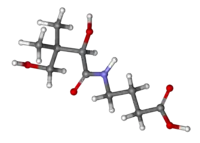Hopantenic acid
Hopantenic acid (homopantothenic acid), also known as N-pantoyl-GABA, is a central nervous system depressant. Formulated as the calcium salt, it is used as a pharmaceutical drug in the Russian Federation for a variety of neurological, psychological and psychiatric conditions and sold as Pantogam (Russian: Пантогам).[1] It is not approved for use in Europe or the United States.
 | |
 | |
| Names | |
|---|---|
| Preferred IUPAC name
4-[(2R)-2,4-Dihydroxy-3,3-dimethylbutanamido]butanoic acid | |
| Identifiers | |
CAS Number |
|
3D model (JSmol) |
|
| ChEMBL | |
| ChemSpider | |
| KEGG | |
PubChem CID |
|
| UNII |
|
CompTox Dashboard (EPA) |
|
InChI
| |
SMILES
| |
| Properties | |
Chemical formula |
C10H19NO5 |
| Molar mass | 233.264 g·mol−1 |
| Related compounds | |
Related alkanoic acids |
|
Related compounds |
Panthenol |
Except where otherwise noted, data are given for materials in their standard state (at 25 °C [77 °F], 100 kPa).
Infobox references | |
Chemistry
Hopantenic acid is a homologue of pantothenic acid. While pantothenic acid is the amide of D-pantoate and β-alanine, hopantenic acid is the amide of D-pantoate and γ-aminobutyric acid (GABA). This change leads to an additional CH2 in the molecule.[2]
See also
- Methyl pentanoate
- Menthyl isovalerate
References
- Pantogam, drugs.com
- Kopelevich VM, Evdokimova GS, Marieva TD, Shmuilovich LM (1971). "Synthesis of D-homopantothenic acid". Pharmaceutical Chemistry Journal. 5 (9): 534–536. doi:10.1007/BF00771659. S2CID 33296093.
This article is issued from Wikipedia. The text is licensed under Creative Commons - Attribution - Sharealike. Additional terms may apply for the media files.